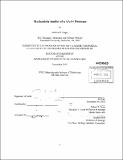| dc.contributor.advisor | Robert T. Sauer. | en_US |
| dc.contributor.author | Nager, Andrew R. (Andrew Ross) | en_US |
| dc.contributor.other | Massachusetts Institute of Technology. Department of Biology. | en_US |
| dc.date.accessioned | 2013-06-17T19:46:13Z | |
| dc.date.available | 2013-06-17T19:46:13Z | |
| dc.date.copyright | 2012 | en_US |
| dc.date.issued | 2013 | en_US |
| dc.identifier.uri | http://hdl.handle.net/1721.1/79189 | |
| dc.description | Thesis (Ph. D.)--Massachusetts Institute of Technology, Dept. of Biology, February 2013. | en_US |
| dc.description | Cataloged from PDF version of thesis. "December 2012." | en_US |
| dc.description | Includes bibliographical references. | en_US |
| dc.description.abstract | AAA+ proteases are present in all branches of life and responsible for the energy-dependent degradation of most cytosolic proteins. Substrates for AAA+ proteases are unfolded and translocated into a compartmental peptidase. The requirement for protein unfolding raises several questions. How easily are proteins unfolded within the native environment of a cell? Are some proteins more difficult to unfold than others, and, if so, why? How do AAA+ ATPases convert the chemical energy of ATP binding and hydrolysis into mechanical unfolding and translocation? ClpXP is a AAA+ protease that consists of the hexameric ClpX unfoldase and polypeptide translocase and the ClpP compartmental peptidase. ClpX binds a substrate by an unstructured degradation tag and then, by multiple rounds of ATP-binding and hydrolysis, unfolds and translocates the substrate into the proteolytic chamber of ClpP. To study the features that allow a protein to resist unfolding, I investigate the degradation of degron-tagged Green Fluorescent Protein (GFP; Chapter 2). By engineering GFP substrates, I determine the steps of GFP unfolding and how structure local to the degron can hinder ClpX-mediated unfolding. In later chapters, my collaborators and I use ensemble and single-molecule fluorescent assays to study the mechanochemical cycle of ClpX6 . By these assays, we observe that subunits adopt unique classes which differ in structure and nucleotide binding and hydrolysis, subunit classes switch in a thermally-driven probabilistic fashion that is decoupled from the chemical cycle, and ClpX 6 form a staircase architecture similar to AAA+ helicases. | en_US |
| dc.description.statementofresponsibility | by Andrew R. Nager. | en_US |
| dc.format.extent | 182 p. | en_US |
| dc.language.iso | eng | en_US |
| dc.publisher | Massachusetts Institute of Technology | en_US |
| dc.rights | M.I.T. theses are protected by
copyright. They may be viewed from this source for any purpose, but
reproduction or distribution in any format is prohibited without written
permission. See provided URL for inquiries about permission. | en_US |
| dc.rights.uri | http://dspace.mit.edu/handle/1721.1/7582 | en_US |
| dc.subject | Biology. | en_US |
| dc.title | Mechanistic studies of a AAA+ protease | en_US |
| dc.title.alternative | Mechanistic studies of a AAA plus protease | en_US |
| dc.type | Thesis | en_US |
| dc.description.degree | Ph.D. | en_US |
| dc.contributor.department | Massachusetts Institute of Technology. Department of Biology | |
| dc.identifier.oclc | 844348933 | en_US |
